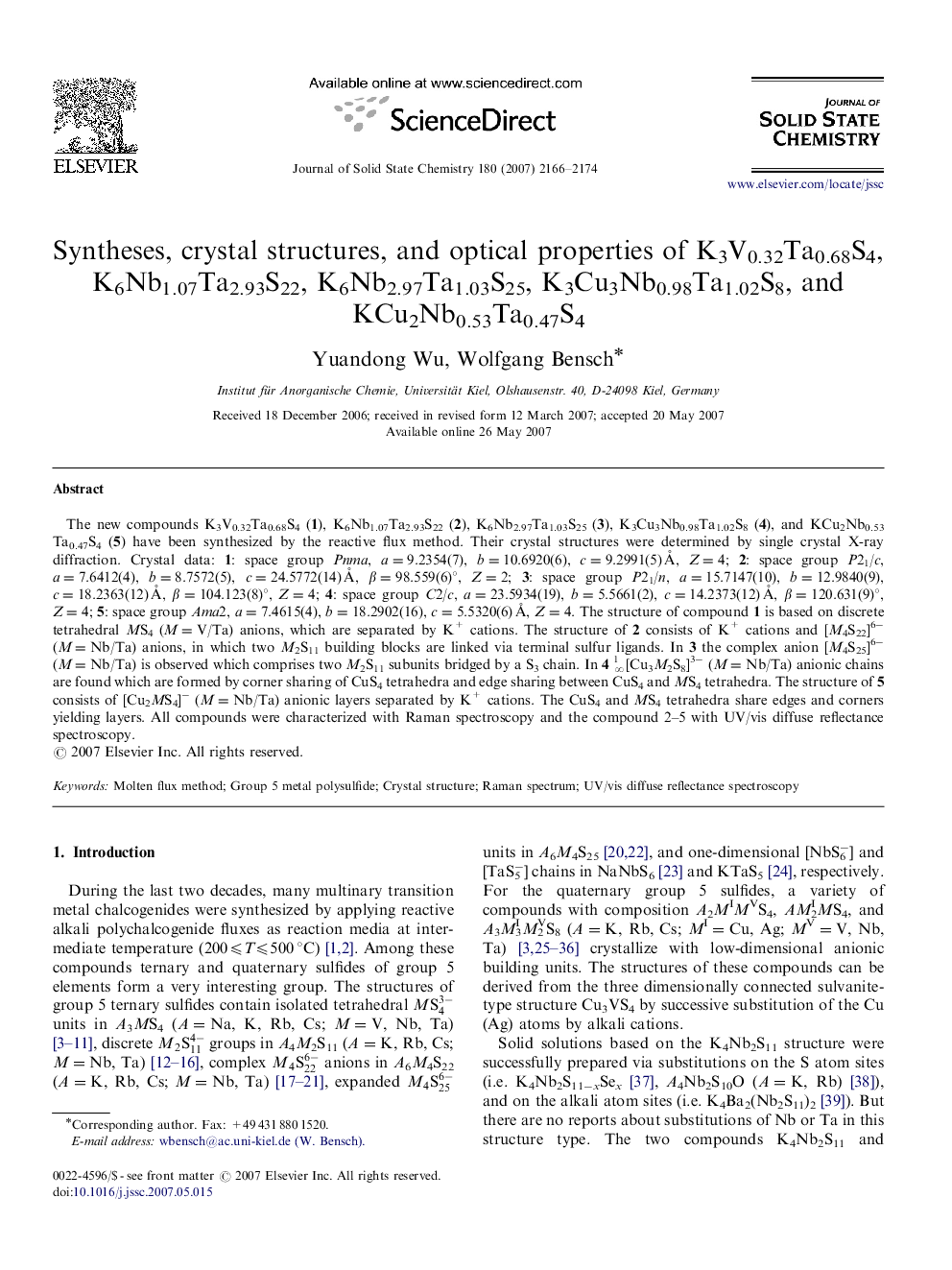| Article ID | Journal | Published Year | Pages | File Type |
|---|---|---|---|---|
| 1331587 | Journal of Solid State Chemistry | 2007 | 9 Pages |
The new compounds K3V0.32Ta0.68S4 (1), K6Nb1.07Ta2.93S22 (2), K6Nb2.97Ta1.03S25 (3), K3Cu3Nb0.98Ta1.02S8 (4), and KCu2Nb0.53Ta0.47S4 (5) have been synthesized by the reactive flux method. Their crystal structures were determined by single crystal X-ray diffraction. Crystal data: 1: space group Pnma, a=9.2354(7), b=10.6920(6), c=9.2991(5) Å, Z=4; 2: space group P21/c, a=7.6412(4), b=8.7572(5), c=24.5772(14) Å, β=98.559(6)°, Z=2; 3: space group P21/n, a=15.7147(10), b=12.9840(9), c=18.2363(12) Å, β=104.123(8)°, Z=4; 4: space group C2/c, a=23.5934(19), b=5.5661(2), c=14.2373(12) Å, β=120.631(9)°, Z=4; 5: space group Ama2, a=7.4615(4), b=18.2902(16), c=5.5320(6) Å, Z=4. The structure of compound 1 is based on discrete tetrahedral MS4 (M=V/Ta) anions, which are separated by K+ cations. The structure of 2 consists of K+ cations and [M4S22]6− (M=Nb/Ta) anions, in which two M2S11 building blocks are linked via terminal sulfur ligands. In 3 the complex anion [M4S25]6− (M=Nb/Ta) is observed which comprises two M2S11 subunits bridged by a S3 chain. In 41∞[Cu3M2S8]3− (M=Nb/Ta) anionic chains are found which are formed by corner sharing of CuS4 tetrahedra and edge sharing between CuS4 and MS4 tetrahedra. The structure of 5 consists of [Cu2MS4]− (M=Nb/Ta) anionic layers separated by K+ cations. The CuS4 and MS4 tetrahedra share edges and corners yielding layers. All compounds were characterized with Raman spectroscopy and the compound 2–5 with UV/vis diffuse reflectance spectroscopy.
Graphical abstractThe five compounds K3V0.32Ta0.68S4, K6Nb1.07Ta2.93S22, K6Nb2.97Ta1.03S25, K3Cu3Nb0.98Ta1.02S8, and KCu2Nb0.53Ta0.47S4 have been prepared in polychalcogenide melts. The structures of these compounds base on discrete tetrahedra [MS4]3− (M=V/Ta), complex [M4S22]6− and [M4S25]6− anions comprised of two M2S11 subunits bridged by a S2 or S3 chain, 1∞[Cu3M2S8]3− anionic chains, and 2∞[Cu2MS4]− (M=Nb/Ta) anionic layers formed by corner sharing and edge sharing between CuS4 and MS4 tetrahedra.Figure optionsDownload full-size imageDownload as PowerPoint slide
